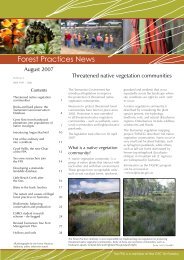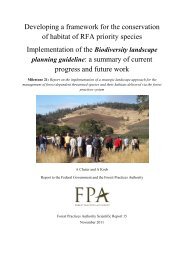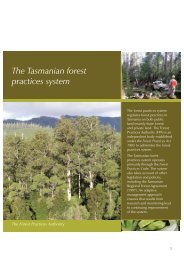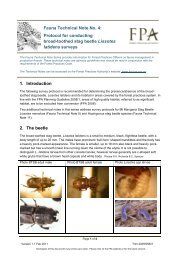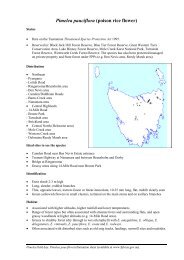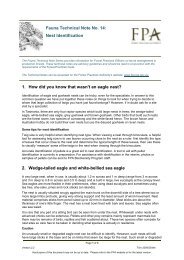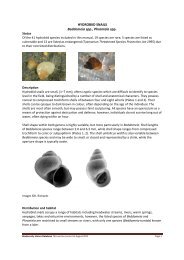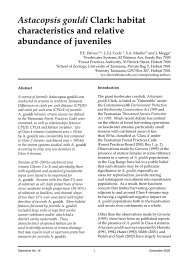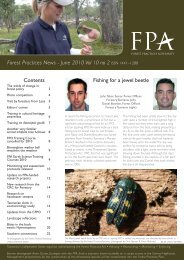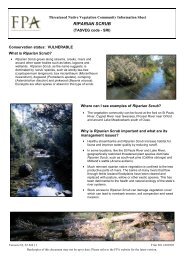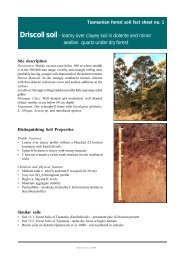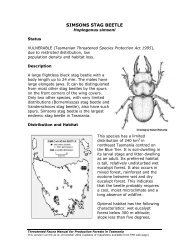FPN vol 7 no 4 December 2006 - The Forest Practices Authority
FPN vol 7 no 4 December 2006 - The Forest Practices Authority
FPN vol 7 no 4 December 2006 - The Forest Practices Authority
Create successful ePaper yourself
Turn your PDF publications into a flip-book with our unique Google optimized e-Paper software.
Award-winning montane grassland management (continued)Romney Marsh, in <strong>no</strong>rth-west Tasmania, during a managed burn. (Photograph by Gunns)lay their eggs in the Poa tussocksin autumn, and the larvae – whichemerge about six weeks later – subsiston this rather mundane (but high fibre!)diet until they metamorphose earlythe following autumn. Gunns conductannual monitoring of Ptunarra brownbutterfly abundance during the autumnflight season, using permanent transectsthat were first established on SurreyHills by staff of the Threatened SpeciesSection in 1997. Dr Phil Bell is one ofthe key TSS specialists who providesadvice to Gunns on management of thebutterfly.Information on the distribution ofthe grassland communities, theirconservation status and the resultsof annual burning and butterflymonitoring programs are collected andmaintained by the NWRMT on Gunns’GIS using the latest GPS tech<strong>no</strong>logy,aerial photographs and recent satelliteimagery.<strong>The</strong> NWRMT has also been activelyin<strong>vol</strong>ved with the promotion of theimportance of grassland conservationwithin and outside the forest industry.<strong>The</strong> grassland sites have been a focusfor a number of scientific field days,bringing together Tasmania’s foremostauthorities on grassland management toimpart their k<strong>no</strong>wledge to a new cohortof forest managers. (At one of thosefield days, a sharp-eyed botanist <strong>no</strong>tedan unfamiliar plant that on investigationproved to be a new species of leekorchid,Prasophyllum crebriflorum).This year, the NWRMT developeda grassland management brochurethat the public can access on Gunns’website <strong>The</strong>brochure was also expanded into aprominent explanatory sign installedat a picnic area on the MurchisonHighway adjoining one of Gunns’ maingrassland reserves.In presenting the award, AustralianEnvironment Foundation (AEF)Chairman Don Burke said thatgrassy ecosystems are among themost endangered plant communitiesin the world. Gunns had beenrecognised by the Foundation fortheir active management of morethan 2000 ha of high conservationvalue native grasslands and highlevels of biodiversity. He commentedthat Gunns’ grassland managementprogram had nurtured an abundance ofindividual plant species, assuring nativehabitat and survival of endangeredspecies such as the Ptunarra brownbutterfly.Management of the <strong>no</strong>rth-westgrasslands has in<strong>vol</strong>ved a great deal ofco-operation between many differentindividuals and organisations overthe years – including Gunns, North<strong>Forest</strong> Products, <strong>Forest</strong>ry Tasmania,the <strong>Forest</strong> <strong>Practices</strong> <strong>Authority</strong>, DPIWand the University of Tasmania. It isvery rewarding to see that the hardwork and success of the grasslandmanagement program has beenrecognised.Authors’ contacts:Fred.Duncan@fpa.tas.gov.auChris.Davey@gunns.com.auGrassland enthusiasts on a field day looking at species diversity on Peak Plain (St Valentines Peak in thebackground). (Photograph by Wray Watts)<strong>Forest</strong> <strong>Practices</strong> News <strong>vol</strong> 7 <strong>no</strong> 43
Review of the <strong>Forest</strong> <strong>Practices</strong> CodeGraham Wilkinson, Chief <strong>Forest</strong> <strong>Practices</strong> Officer,<strong>Forest</strong> <strong>Practices</strong> <strong>Authority</strong><strong>The</strong> year 2007 marks the 20thanniversary of the first <strong>Forest</strong> <strong>Practices</strong>Code in Tasmania, and it marksthe year for a<strong>no</strong>ther major reviewand revision of the code. <strong>The</strong> firstdraft code was developed after theintroduction of the <strong>Forest</strong> <strong>Practices</strong>Act 1985. <strong>The</strong> draft was extensivelyfield-tested and revised before beingformally released as the 1987 code.Further reviews and revisions resultedin the 1993 and 2000 editions. <strong>The</strong>commitment to ongoing review andimprovement of the code continuesand in 2007 a major review will beinitiated by the board of the <strong>Forest</strong><strong>Practices</strong> <strong>Authority</strong> in consultation withthe <strong>Forest</strong> <strong>Practices</strong> Advisory Council.<strong>The</strong> review will be conducted asfollows:1. <strong>The</strong> general provisions of the codewill be reviewed by a technicalworking group convened by the<strong>Forest</strong> <strong>Practices</strong> Advisory Council,which comprises representativesof stakeholders includingforest managers, landowners,conservation scientists, localgovernment and forest workers.<strong>The</strong> technical working group willdraw upon the expertise andexperience of <strong>Forest</strong> <strong>Practices</strong>Officers, FPA staff, stakeholders,other practitioners and scientists.<strong>The</strong> report of the working groupwill be submitted to the <strong>Forest</strong><strong>Practices</strong> Advisory Council forstakeholder review and advice tothe board of the FPA.2. A thematic review of thebiodiversity provisions of the codewill be undertaken by an expertpanel in parallel with the abovegeneral review. <strong>The</strong> expert panelwill be independently chairedby Dr Mick Brown and will besupported by a team of scientificand forest management experts.<strong>The</strong> expert panel will submit itsreport to the <strong>Forest</strong> <strong>Practices</strong>Advisory Council for stakeholdercomment and advice to the boardof the FPA.3. <strong>The</strong> board of the FPA will prepareand release a draft code for publiccomment. Submissions from thepublic and other bodies will bereviewed by the board and takeninto account when finalising thenew edition of the code.<strong>The</strong> board expects to have a new codein place by mid 2008.In the interim, <strong>Forest</strong> <strong>Practices</strong> Officersare encouraged to submit ideas aboutimprovements to the code. You cansend your comments/thoughts directlyto the code coordinator Chris Mitchell(chris.mitchell@fpa.tas.gov.au) orto your representative on the <strong>Forest</strong><strong>Practices</strong> Advisory Council.Full briefings on any proposed changesto the code will be carried out with all<strong>Forest</strong> <strong>Practices</strong> Officers as part of thereview process.Author contact:Graham.Wilkinson@fpa.tas.gov.auEditors’ CornerThis is the last issue for <strong>2006</strong>, and wethank all contributors. We had a goodresponse to the FPO interviews wepublished this year and plan to includemore interviews in future issues. Onthe matter of FPOs, we are alwaysinterested in receiving short anecdotesand photographs, funny or serious,about FPOs and foresters. If you’vediscovered a rare plant, received anenvironmental award, found an oddlandform, taken a great picture of somewildlife, or won the forest contractors’poetry competition we’ll be interestedto hear from you, preferably with aphoto attached. If you don’t consideryourself to be a writer, just send aphoto and a caption.Longer articles are still welcome.<strong>The</strong>se can be based on issues foundin coupes, but think about sendingin articles on what you’ve see<strong>no</strong>n the mainland or overseas, oron a conference field trip, or yourcomments on that memorable trainingcourse. Book reviews, comments onpublications and letters to the editorhardly feature in <strong>Forest</strong> <strong>Practices</strong> News– yet we would welcome them.Please include illustrations and a photoof yourself with your contributions andensure that figures/pictures are sent asseparate files and <strong>no</strong>t embedded inWord documents.Contributions can be supplied eitheras hard copy or electronically. Ifforwarding material electronically, theaddress is:Christine.Grove@fpa.tas.gov.au .<strong>The</strong> Editors wish all FPOs and otherreaders a safe and prosperous 2007– may the rains come and the firessubside.Christine Grove and Peter McIntosh<strong>Forest</strong> <strong>Practices</strong> News EditorsDeadline for contributionsfor the next <strong>FPN</strong>:Mid-May 20074<strong>Forest</strong> <strong>Practices</strong> News <strong>vol</strong> 7 <strong>no</strong> 4
Home range size, habitat use and diet of the endangered Tasmanianmasked owlDavid Young, Zoology Department, University of Tasmania, in collaboration with theTasmanian Threatened Species Section, Nature Conservation Branch, DPIW.Under the cover of darkness there is aworld rarely seen … a world travelledby creatures of the nightshift. Amongthese, the owls are the supremehunters, flying soundlessly like shadows,flying on wings of silence.(Young, 1998).Tasmania’s forests are home to thesecond largest <strong>no</strong>cturnal raptor inAustralia, the Tasmanian masked owlTyto <strong>no</strong>vaehollandiae casta<strong>no</strong>ps. <strong>The</strong>Tasmanian masked owl is a large,endemic, hollow-dependent forest owlthat is currently listed as endangeredin the Tasmanian Threatened SpeciesProtection Act 1995. <strong>The</strong> major threatsto masked owls are the loss of oldgrowth forests (that are needed fornesting) as a result of commercialforestry operations, land clearing foragriculture and urbanisation, firewoodcollecting and natural attrition (Bell etal., 1997).I recently radio-tracked two femalemasked owls in the Huon Valley atCrabtree and Mountain River to assesstheir home range, the habitats theyused most frequently and their diet,as little is k<strong>no</strong>wn about the ecology ofthese owls. <strong>The</strong> home range or territoryfor each owl was approximately 1800-2500 ha in a highly modified ruralagricultural area. <strong>The</strong> home rangesconsisted of a mosaic of forest andopen pasture areas and were situatedprimarily on private property. Both theradio-tagged owls preferred to forageat night in relatively small patchesof forest (0-20 ha) with little or <strong>no</strong>understorey. However, they roostedduring the day in larger forest patches(20-100 ha) with a dense understoreyadjacent to small creeks or drainagelines This highlights the importanceof streamside reserves for conservingmasked owl habitat in Tasmania.<strong>The</strong> diet of both owls was assessedby collecting regurgitated pellets fromtheir roost sites, as this is where mostpellets accumulate. Eastern barredbandicoots were the most importantspecies in the diet, closely followedby eastern swamp rats and Tasmanianpademelons. Yes, they hunt and eatTasmanian pademelons, even thoughthey are three to four times their size!Introduced species such as black ratsand rabbits were also important preyitems.<strong>The</strong> apparent preference displayed bythe radio-tagged owls for forest edgesand highly modified forest pasturemosaic, suggests that masked owlsmay actually benefit from habitatfragmentation and the resultingincrease in productive foraginghabitat. However, the high mortalityrates associated with these urbanisedenvironments probably counteract thisbeneficial effect.David Young with a masked owl he radio-tracked near Crabtree in the Huon Valley.<strong>Forest</strong> <strong>Practices</strong> News <strong>vol</strong> 7 <strong>no</strong> 4ReferencesBell, P, Mooney, N, Wiersma, J,1997, Predicting essential habitat forforest owls in Tasmania, report to theTasmanian Regional <strong>Forest</strong> AgreementEnvironment and Heritage Committee.Young, J, 1998, Wings of Silence, RSmith Productions, Qld, Australia.Author contact:dayoung@postoffice.utas.edu.au5
Erin Flynn – First successful applicant for<strong>Forest</strong> <strong>Practices</strong> <strong>Authority</strong> Student Research AwardsDr Sarah Munks, Senior Zoologist and Research Co-ordinator, <strong>Forest</strong> <strong>Practices</strong> <strong>Authority</strong>In 2005 the <strong>Forest</strong> <strong>Practices</strong> <strong>Authority</strong>established a student research grant toencourage applied research that willcontribute to the development of theforest practices system. <strong>The</strong> researchgrants, advertised on the FPA website, are available for university postgraduatestudents (or equivalent) forresearch expenses up to the value of$2000 per project.<strong>The</strong> first successful applicant in <strong>2006</strong>was Erin Flynn. Erin is from ColoradoState University in the USA where shestudied how the environment affectsthe physiology of animals. She madea brief visit to Tasmania in 2004 tostudy at the Zoology Department atthe University of Tasmania, where sheattended courses in reproduction andendocri<strong>no</strong>logy for conservation. She fellin love with the island and its wildlifeand so in <strong>2006</strong> she decided to returnto the State to work on her Master ofScience Degree at the University ofTasmania.Erin’s project will provide newinformation on the ecology of our mostcommon hollow user, the commonbrushtail possum. Although thebrushtail possum is common, relativelylittle is k<strong>no</strong>wn about its ecology in thisstate. Her study aims to determinethe influence of vegetation typeand habitat disturbance on brushtailpossum population size, population,structure, and physiological well-being.<strong>The</strong> results of her work will enablebrushtail possums to be assessed asan indicator species for monitoringthe effects of forestry disturbance onarboreal marsupials. She will work atsites established by the FPA to monitorthe survival and use of wildlife habitatclumps.Erin started her fieldwork recently andhas had to deal with the unpredictablenature of the Tasmanian environment,including a close encounter with abushfire at her study site at Kellevie.We wish her well with her project andlook forward to future <strong>Forest</strong> <strong>Practices</strong>News articles as her work progresses.Author contact:Sarah.Munks@fpa.tas.gov.auErin releasing a possum, which can’t get away fast e<strong>no</strong>ugh. (Photograph by Lisa Cawthawn)6<strong>Forest</strong> <strong>Practices</strong> News <strong>vol</strong> 7 <strong>no</strong> 4
Forward Training Programme – <strong>Forest</strong> <strong>Practices</strong> <strong>Authority</strong>Confirmed and proposed training 2007Course (Contact) Timing Duration Location Course ContentFauna field days(Ecology program)Autumn 20071 dayTo be advisedAccreditation in eagle nest search methods andnest activity checking methodsFauna field days(Zoology program)July 20071 dayNWTasmaniaUpdate on latest giant freshwater crayfish researchand management toolsFauna coursesQuarry <strong>Forest</strong> <strong>Practices</strong>Officer 1(Chris Mitchell)Landscape simulationsand 3D analysisworkshop (BruceChetwynd)March 2007May – June20072-3 days(each)NE, NW,S and CNWinter 2007 2 days To be advisedWinter 2007 1 day To be advisedProvision of ecological and managementinformation of threatened species in each region.Revision of planning tools.Train quarry managers who will then be given theauthority to certify FPPs for quarriesSharing of techniques and expansion of skills onseen-area/ 3D analysis and computer simulationsof forest landscapes2007 <strong>Forest</strong> <strong>Practices</strong>Officer course(Chris Mitchell)July to October200712 daystotalVariousPre-requisite course for appointment as FPORisk assessment(Chris Mitchell)Invertebrate fieldday (Zoology/Ecologyprogram)<strong>Forest</strong> Botany(Fred Duncan)<strong>Forest</strong> practices trainingfor supervisors 1(Chris Mitchell)Cultural heritage(Denise Gaughwin)Autumn 2007Spring 2007February 20071 day1 day1 day1 location eachin south and<strong>no</strong>rthNWTasmaniaSE, NE, NWTasmaniaMay 2007 4 days To be advisedAutumn 2007 4 days To be advisedTrain additional FPOs in<strong>vol</strong>ved in FPP preparationto conduct risk assessments where trees are beingretained under the <strong>Forest</strong> <strong>Practices</strong> CodeGeneral introduction to invertebrate conservationvia the forest practices system, with a focus onthreatened invertebrates in NW Tasmania.Flora of Tasmania; identification of species andcommunities; forest ecology; management andlegislationGeneral training in forest practices for forestindustry supervisorsProvides accreditation in cultural heritage withemphasis on the recognition, recording andmanagement of Aboriginal and Historic sites1Course will be run jointly by <strong>Forest</strong>ry Tasmania and <strong>Forest</strong> <strong>Practices</strong> <strong>Authority</strong> and is dependent on demand.<strong>Forest</strong> <strong>Practices</strong> Officers: are you moving?To help us maintain an accurate database and to ensure that circulars reach you,please advise us if you are transferring, resigning or retiring.Festive Greetings from Adrienne, Joan and Sheryl. Phone:(03) 6233 7966 Email: info@fpa.tas.gov.au<strong>Forest</strong> <strong>Practices</strong> News <strong>vol</strong> 7 <strong>no</strong> 47
What’s going on at the top of the catchment? -headwater stream symposium and field dayDr Sarah Munks, Senior Zoologist and Research Coordinator, <strong>Forest</strong> <strong>Practices</strong> <strong>Authority</strong>A one day symposium and field day toupdate forest managers, planners andother researchers on headwater streamresearch and monitoring work inTasmania was held in August with thesupport of the CRC <strong>Forest</strong>ry.Management of headwater streamswas raised as an important issueby both foresters and the generalpublic during the 1999 review ofthe Tasmanian <strong>Forest</strong> <strong>Practices</strong> Code.<strong>The</strong> review panel recommendedfurther work to assess the intensityand duration of the impact of forestryoperations on headwater streams andthe extent of impacts downstream.<strong>The</strong> panel also recommended workon the effectiveness of currentheadwater stream managementprovisions. A program of collaborativework, with other research providers,commenced in 1999 to addressthese recommendations. <strong>The</strong> aim ofthe symposium and field day was toprovide forest managers/planners andother researchers with a summary ofthe research and monitoring work thathas been undertaken to date. A day8of talks was followed by a field dayto discuss outcomes and implicationsof the research for management ofheadwater streams in productionforests.<strong>The</strong> event was well attended with50 participants from a range oforganisations. This included <strong>Forest</strong><strong>Practices</strong> Officers, forest managersand CRC <strong>Forest</strong>ry researchers fromVictoria. <strong>The</strong> symposium began with areview of the structure, function andmanagement of headwater streamsin timber production forests by DrWayne Erskine from the University ofNewcastle. A series of speakers thenpresented the results of studies thathave looked at the intensity and extentof the impact of forestry practices onthe biology and habitat of headwaterstreams. <strong>The</strong>se included a summary ofthe work carried out on the impact ofpre-code clearfelling on Class 4 streamsin the Ben Nevis area.<strong>The</strong> Ben Nevis retrospective studyfound that 15 years after harvesting,impacts on stream geomorphologyIn the symposium fieldtrip, Peter McIntosh (of the <strong>Forest</strong> <strong>Practices</strong> <strong>Authority</strong>) shows how to assess soilerodibility, which is an essential component of erosion hazard analysis of headwater streams.PhD student Joanne Clapcott explains how smallweirs were used to provide short-term flowmeasurements on headwater streams in the WarraLong Term Ecological Research Site.and benthic invertebrates were stillevident. Platypuses also appearedto avoid the small streams that hadbeen disturbed by the logging. <strong>The</strong>seimpacts were related to both the directand indirect effects of the harvestingwithin the catchments of the streams.It was <strong>no</strong>ted, however, that the currentcode provisions for the protection ofheadwater streams aim to avoid directeffects of harvest, such as felling intothe stream and dragging of logs throughthe streams. However, indirect effects,such as those that result from increasedstream flow as picked up in the BenNevis study, may still occur today.This conclusion was supported by theresults of two recent PhD studies, byJoanne Clapcott and John Gooderham,that looked at changes withinmacroinvertebrate communities and ofstream habitat resulting from forestrypractices regulated by the current code.<strong>The</strong> session on habitat and biologywas followed by presentations of workcarried out by the FPA’s Peter McIntoshand others over the past 5 years toimprove the management of class 4streams, including the development ofnew guidelines that include increased<strong>Forest</strong> <strong>Practices</strong> News <strong>vol</strong> 7 <strong>no</strong> 4
What’s going on at the top of the catchment? -headwater stream symposium and field daystream buffers designed to limitthe impact of forestry practices onheadwater stream erosion. Terry Warefrom the Huon District of <strong>Forest</strong>ryTasmania presented an interesting casestudy that highlighted the challengesfacing forest planners when trying tocater for all special values, includingstream values, when designing aharvesting operation. He demonstratedthat with careful planning potentialimpacts on headwater streams can beminimised.<strong>The</strong> field day to the Warra Long TermEcological Research Site in<strong>vol</strong>vedlots of stumbling up muddy tracks,peering at tiny streams, sharing ofproblems and exchange of ideas onhow to best protect Class 4 streamsand their riparian areas during forestryoperations. Wayne Erskine, from theUniversity of Newcastle, and LeonBarmuta, from UTAS, provided a usefulsummary of the issues and the strengthsand weaknesses of the research.It was clear from the research andplanning examples given at thesymposium that good progress hasbeen made in limiting direct effectsof forestry operations on headwaterstreams: <strong>The</strong> code limits activities nextto streams and provides rules on roadbuilding and stream crossings, and thenew Class 4 guidelines identify at-riskstreams requiring increased riparianprotection. However indirect effects,derived largely from increased flowafter harvest, are more difficult toaddress. This is because of the widevariation between streams and thevariety of forest land uses around them,ranging from conversion of native forestto plantation through to partial harvestsystems.In the discussion held at thesymposium, participants <strong>no</strong>ted thathaving more streamside reservescould go some way to addressingthese issues but they could <strong>no</strong>t fullyaddress them. Channel morphology iscontrolled by flood discharge, sedimentload, and sediment and vegetationtypes in a catchment, as well as byriparian vegetation, so applying ariparian buffer to reduce direct impactsdoes <strong>no</strong>t guarantee channel stability.<strong>Forest</strong> <strong>Practices</strong> News <strong>vol</strong> 7 <strong>no</strong> 4Symposium delegates inspect the effects of recent harvest and plantation establishment on a headwaterstream.Restrictions on catchment harvest areaand the adoption of partial harvestingsystems were raised as other streammanagement tools.Work on the extent of impacts offorest harvesting on water quality,sediment transport, erosion andbiology in downstream reaches iscontinuing, both in Tasmania and onthe mainland. A major current projectis the FPA Soil and Water headwaterstream monitoring network designed toevaluate the effectiveness of the newClass 4 stream guidelines.We still have work to do and decisionsto make regarding the conservationmanagement of our stream ecosystemsin the forestry estate. Both the workand the management decisionsmade will require co-operationamong researchers, forest managersand planners. <strong>The</strong> symposiumdemonstrated the close links that existbetween researchers, managers andfield practitioners, which are partlya result of the cooperative principleunderpinning the forest practicessystem in Tasmania.<strong>The</strong> <strong>Forest</strong> <strong>Practices</strong> Research WorkingGroup plans to hold annual informationevents (called What’s New?) toupdate forest managers, planners andother researchers on forest practicesrelated research topics and to discussmanagement implications.Author contact:Sarah.Munks@fpa.tas.gov.au<strong>The</strong> following quotes come from anexhibition of Chinese nature paintings,which was at the National Gallery ofVictoria in <strong>2006</strong>:<strong>The</strong> wise find pleasure in streams/water<strong>The</strong> virtuous find pleasure in mountains.Confucius (6th-5th Century BC)Watercourses are the arteries ofmountains;Grass and trees its hair;Mist and haze its complexion;Stones are the bones of heaven andearth…Water is the blood of heaven andearth…Gao Xi (after 1000 A.D.)To tranquilise one’s mind is to <strong>no</strong>urishone’s spirit;To <strong>no</strong>urish the spirit is to return tonature.Daoist psalm9
<strong>Forest</strong> <strong>Practices</strong> Officers:a key element of the forest practices systemChris Grove, Communications Officer, <strong>Forest</strong> <strong>Practices</strong> <strong>Authority</strong>What job do you do?I am an independent forestryconsultant with my own business, TASLand and <strong>Forest</strong>. I am currently trainingan employee to work alongside me.At times I employ up to ten people tomeet demand for our services.What training and experience haveyou had to enable you to do thejob?I started work in forestry 36 years ago.At the time I was training as a teacherand <strong>no</strong>t enjoying it. I happened to walkhome one day past the old <strong>Forest</strong>ryCommission offices and k<strong>no</strong>cked on10Brett Millertheir door to ask for a job. I started thenext day as a labourer. I then began acadetship and trained as a technicalforester. I’ve had experience in workingfor the government and private industrysectors and have been an independentconsultant for the past six years.I was accredited as an FPO in the firstbatch of FPOs and have done manyFPA courses since then. Training startedoff with the FPA specialists runningtheir own courses. <strong>The</strong>y were moreinformal and relaxed in the old days –on the first archaeology course we hada hangi and free beer on the first nightwhich helped everyone to get to k<strong>no</strong>weach other. Now everything is muchmore streamlined and professional– and <strong>no</strong>t as much fun.My trainee and I have just completeda wedge-tailed eagle course where welearnt how to identify eagles’ nests andwhat measures to take to protect them.I estimate that between the cost of thecourse, travel and missed earnings itSelective harvesting must ensure that retained stems are <strong>no</strong>t damaged and requires monitoring by a<strong>Forest</strong> <strong>Practices</strong> Officer. (Photo by Brett Miller)has cost me around $2500. As is thecase for the corporate forestry bodies,it is a cost that has to be incurred to dobusiness.<strong>The</strong> forest practices system is <strong>no</strong>w verysophisticated, with new regulationsbeing incorporated into what is alreadya very complex system.What does your role as an FPOin<strong>vol</strong>ve?My clients are <strong>no</strong>rmally referredto me by word of mouth. <strong>The</strong>re isoften confusion by the general publicabout who is the “face of forestry”. Ioften have to advise regarding issuesthat should best be dealt with bygovernment agencies because the trailto the correct government agency is sodifficult to follow.To prepare an FPP, I meet with theclient for an initial consultation andexplain the process of preparing anFPP and how the forest practicessystem works. I estimate the value ofthe timber (sometimes it is only landclearing) and, if the landowner wantsto proceed, I check the boundariesand creeks and other things I need toconsider in the FPP. Depending on thecomplexities in the FPP, it may takeme anything from two weeks to twoyears to prepare the FPP. I have onecase which is still <strong>no</strong>t resolved twoyears down the track due to complexthreatened species issues.Neighbour <strong>no</strong>tification, as is requiredby the <strong>Forest</strong> <strong>Practices</strong> Act 1985,often in<strong>vol</strong>ves lengthy discussion, andperhaps modification to the FPP tosatisfy the needs of both parties.I work closely with one harvestingcontractor who can be relied upon todo the job well. He contracts me tooversee the operation to ensure thathis harvesting operation complies withthe <strong>Forest</strong> <strong>Practices</strong> Code. Every effortis made to phrase the FPP in plainlanguage to ensure that the FPP will beread and understood.<strong>Forest</strong> <strong>Practices</strong> News <strong>vol</strong> 7 <strong>no</strong> 4
<strong>Forest</strong> <strong>Practices</strong> Officers:a key element of the forest practices systemPlanning for archaeological sites is often very interesting. <strong>The</strong> remains of this 1930s shepherd’s hutwere discovered when preparing a <strong>Forest</strong> <strong>Practices</strong> Plan in the Central Highlands. <strong>The</strong> <strong>Forest</strong> <strong>Practices</strong><strong>Authority</strong>’s archaeologist was <strong>no</strong>tifed and prescriptions developed to protect the site. (Photograph byBrett Miller)About 80 per cent of my work is forsmall landowners and the rest is for bigforest industry companies. <strong>The</strong> amountof work in preparing an FPP for a smalllandowner with, say, five ha and 750 tof timber is just the same as for a largecoupe, of say 50 ha and 10,000 t oftimber, which is generally the case forindustrial forestry.What are the challenges in yourjob?I don’t have any peer review of FPPswhich I prepare. <strong>The</strong>re is some roomfor the interpretation of the forestpractices system when preparing anFPP. When you operate independentlythe buck stops with you and youhave to rely on stringent self-reviewto produce plans that are clear andunambiguous.<strong>The</strong> legislation dealing with threatenedspecies is challenging. I always find theFPA specialists excellent to deal withbut the process of preparing an FPPwith threatened species in<strong>vol</strong>ved is verydifficult. <strong>The</strong> Conservation AssessmentSection within the Department ofPrimary Industries and Water isunderstaffed, and with the currentlevels of clearing activity occurringwithin the state, threatened speciesmanagement is a major issue. Thisprocess often significantly delays theprocessing of a FPP.It would be good to see the systemmade more streamlined and simple buton the other hand it’s the complexityin the system which means that it canstand up to scrutiny. Simplifying it toomuch would leave it open to criticism.What are the things you really enjoyabout your job?I really enjoy the variety in my job.I get to work all over the state in alldifferent types of forest – from pineplantations to native forest. I meetlots of interesting people – every dayis different. I try to avoid red tape inmy business and keep things rolling.We have a policy of <strong>no</strong> meetings – ourmeetings are usually held over a beerat the end of the day! Because I amindependent I can choose which jobsI do - if I don’t click with a landownerI’ll tell them I’m too busy to do the job.It’s satisfying seeing the process throughfrom start to finish.What would you like to seechanged about the forest practicessystem?You can have a great FPP butif the contractor doesn’t read itproperly or understand it then thechances are there will be potentialproblems. Training contractors inthe interpretation of FPPs and a fullunderstanding of the code would goa long way to minimising this. Whilstthere are active training schemes inplace, there are some contractorsoperating outside of the “trainingumbrella” that could improveperformance with additional support.Landowners are <strong>no</strong>t in the culture ofbeing bound by codes of practicesbecause there is <strong>no</strong> agricultural codeof practice. <strong>The</strong>re are still a lot ofland managers who are unaware oftheir responsibilities under the <strong>Forest</strong><strong>Practices</strong> Code, even though the codehas been in place for 25 years. Farmersare accustomed to treating their creeksas they see fit – they can let stock intothem, drive tractors across them andspray around them. So being boundby the <strong>Forest</strong> <strong>Practices</strong> Code is a <strong>no</strong>velconcept for them. I’d like to see anagricultural code of practice in place.Author contacts:Christine.Grove@fpa.tas.gov.aubrett.miller@bigpond.comVisual management planning often in<strong>vol</strong>ves negotiating a compromise to meet both visual managementobjectives and a landowner’s desire to maximise return.<strong>Forest</strong> <strong>Practices</strong> News <strong>vol</strong> 7 <strong>no</strong> 411
Solution to the Monkey Puzzle!Tim Leaman, Conservation Planner, <strong>Forest</strong>ry Tasmania (left)Fred Duncan, Senior Botanist, <strong>Forest</strong> <strong>Practices</strong> <strong>Authority</strong> (right)An article in the last issue of <strong>Forest</strong><strong>Practices</strong> News (September <strong>2006</strong>)reported on a single plant of Araucariaaraucana (the Monkey Puzzle tree)growing next to Lone Star Road inTasmania’s <strong>no</strong>rtheast. <strong>The</strong> plant hadbeen discovered and photographed byWayne Radford of Bass District.<strong>The</strong> Monkey Puzzle is a conifer nativeto southern Chile and a small area ofArgentina. It is a distinctive tree withan umbrella-shaped ca<strong>no</strong>py. It is <strong>no</strong>wprotected in both countries, but inthe past its timber was used, mainlyfor structural purposes and joinery.Its seeds are large and edible, andwere an important part of the diet ofthe indige<strong>no</strong>us people, including theArauco, after whom the genus andspecies is named. <strong>The</strong> Monkey Puzzletree and other Araucaria species, suchas Norfolk Island pine, were popularornamental plantings, particularly in theVictorian period, and mature trees canbe seen in a few places in Tasmania.<strong>The</strong> Lone Star Araucaria was only abouttwo metres in height, but was in goodcondition, despite competition fromcutting grass and other plants. Wewondered why it was growing there,so far from home. Was it planted, orwas it a wildling that had developedfrom seed dispersed by birds or othermeans?<strong>The</strong> mystery of the Monkey Puzzlehas <strong>no</strong>w been solved, so <strong>Forest</strong>ryTasmania Bass District staff can go backto sleeping easily in their beds (and attheir desks). We were deluged withemails (2) from Peter Volker (PrincipalPlantations Scientist in <strong>Forest</strong>ryTasmania’s Division of <strong>Forest</strong> Researchand Development) and Sven Meyer(Project Manager (Pesticides) with theChemical Management Branch of theDepartment of Primary Industries andWater).Peter wrote… ‘<strong>The</strong> tree is next to anE. globulus and E. regnans provenancetrial area which was planted in 197714by Keith Orme (globulus) and CSIRO(regnans). <strong>The</strong> Monkey Puzzle tree wasplanted by Keith in about 1982. I waswith him when he planted it. Keithhad many overseas contacts throughhis pioneering work on seed collectingof different globulus provenances. I’m<strong>no</strong>t sure how he came to have thetree, but I assume someone from Chilesent him some seed and he grew itat home. He had a few seedlings, sohe decided it would be a good ideato plant this one to mark the locatio<strong>no</strong>f the provenance trial. Over the past24 years I’ve watched it growing veryslowly – especially compared to theeucalypts in the trial. Mystery solved!’Sven wrote… ‘I used to work in thePlantations Branch at FT and did somework near this tree about 4 or 5 yearsago. At the time it looked about thesame size (1m). <strong>The</strong> tree was on anunusual genetic (I think globulus) trialsite on the edge of the coupe on theroadside – we felled quite a few treesto look at stress and timber shrinkagebetween different globulus varieties. Icame across a monkey tree somewhereand always suspected that the littletree we found on that block was thesame thing. Maybe it was grown atPerth Nursery along with the unusualglobulus variety and was planted by atree planter for fun, making it about 20years old.’Fred contacted Keith Orme, whoconfirmed that he had planted theseedling, which he had raised fromseed that possibly originated inArgentina, but which he obtained froma French seed company. He plantedit partly as a marker for the E. globulustrial – which was successful – with theblue gums showing much greater MAIthan the new kid on the block. (In fact,blue gum has been a very successful“new kid on the block” in SouthAmerica, with about 370,000 ha of E.globulus plantation in Chile alone).<strong>The</strong>re is something of an internationalthread running through this story,so it is worth mentioning a furtherBass District connection in<strong>vol</strong>vingblue gums, Monkey Puzzle trees anda<strong>no</strong>ther imported wildling – this timefrom Ireland! <strong>The</strong>re would be fewpeople working in Tasmania’s forestswho haven’t heard of Sean Blake – aforester who k<strong>no</strong>ws the <strong>no</strong>rth-east likethe back of his hand. In the 1950s,Sean was a student at a boardingschool in Northern Ireland. Amongsthis strongest memories of those yearswere some inspiring trees in the schoolgrounds. <strong>The</strong>y were Eucalyptus globulusand Araucaria araucana.Authors’ contact:Fred.Duncan@fpa.tas.gov.auTim.Leaman@forestrytas.com.auAraucaria in Chile, taken by Fred on his study tourin 2005 on a Gottstein Fellowship.Editors <strong>no</strong>te: Fred’s report from his study tour toSouth America (Temperate native forests in Chile:management, conservation and forest practices)is <strong>no</strong>w available on the Gottstein Trust websiteat and can also beaccessed through the <strong>Forest</strong> <strong>Practices</strong> <strong>Authority</strong>.<strong>The</strong> report discusses management, conservationand forest practices in Chile’s temperate forests,and relates these to the situation in Tasmania’sforests. Temperate forests in both places sharea flora of Gondwanan origin and have manyecological attributes in common. <strong>The</strong>re arealso similar threads in their management andconservation, both of which have attracted agreat deal of attention. Native forests are used forproduction of wood and other products, and arealso important for the protection of soil and watervalues and biodiversity.<strong>Forest</strong> <strong>Practices</strong> News <strong>vol</strong> 7 <strong>no</strong> 4
End of year reflections by the CFPOGraham Wilkinson, Chief <strong>Forest</strong> <strong>Practices</strong> Officer, <strong>Forest</strong> <strong>Practices</strong> <strong>Authority</strong>In recent years I have been veryprivileged to have worked on variousforestry projects in developing nations.Usually my role has been to provideadvice and conduct training onimplementing codes of forest practice,drawing upon the experience built upwithin Tasmania over the past 20 years.One thing you quickly learn whenworking overseas is that there is <strong>no</strong>‘cookie-cutter’ solution for developingcodes of practice – each one has to becarefully tailored to meet the uniquesocial, governmental, eco<strong>no</strong>mic andenvironmental conditions withineach country. However, there aresome common principles, many ofwhich feature prominently withinTasmania’s forest practices system – theprinciples of a cooperative approachto management and regulation,underpinned by research, training andeducation; an emphasis on planning,supervision and monitoring; and acommitment to continuing review andimprovement.Most developing nations have along and proud tradition of forestuse and stewardship, with manycommunities dependant upon theforests for sustenance, eco<strong>no</strong>micprosperity and spiritual well-being.However, changing demographics anddevelopmental pressures are havingincreasing impacts on the forestsand putting many at risk from overexploitatio<strong>no</strong>r conversion to otherforms of land use.In Australia the disassociation of ourlargely urban society from the realitiesof natural resource use means thatgovernments are under increasingpressure to ‘reserve’ forests and foregotheir eco<strong>no</strong>mic benefits. Tasmania has45 per cent of its forests in formal andinformal reserves, which is more thanthree times the national average. Evenso, the conservation of biodiversitycan<strong>no</strong>t be met from the reservedforests alone and there is a continuingneed for complementary managementof biodiversity within <strong>no</strong>n-reserveforests. At the same time, these forestsare expected to provide a range ofother goods and services such as timberand <strong>no</strong>n-timber products, grazing andrecreation.Regulatory devices such as codes ofpractice have an important role toplay in achieving a reasonable balancebetween forest use and conservation.Developing nations clearly understandthat the forests need to provideongoing eco<strong>no</strong>mic and social benefits,as well as environmental benefits.Ultimately, the eco<strong>no</strong>mic and socialbenefits of forest management must besufficient to cover the cost of protectingthe environmental values.Author contact:Graham.Wilkinson@fpa.tas.gov.auIn Laos, the local community participates in theplanning and implementation of the harvestingplan. A share of the logging revenue is allocatedfor developmental projects.<strong>Forest</strong> <strong>Practices</strong> News <strong>vol</strong> 7 <strong>no</strong> 4Local villagers collect small-wood from forest residues in Vietnam for local processing and use.15
Globe-trotting tree fernSimon Davies, Tree Fern Officer, <strong>Forest</strong> <strong>Practices</strong> <strong>Authority</strong>I recently received an email from aLouise Webster with an enquiry abouta tree fern she had purchased. Louisehad bought a Tasmania Dicksoniaantarctica from a Melbourne nurseryand was curious about its origin. Aquick check of the Tree Fern Tagnumber on the database revealed thatthe fern originated from a Black Riverforest coupe, which is situated in <strong>no</strong>rthwestTasmania near Crayfish Creek.Louise was very happy that her treefern was from the Circular Head areaas she had family ties to the area datingback to the 1860s.Louise informed me that she wasactually living in <strong>no</strong>rthern Italy in asmall village approximately 30 kmfrom Milan. As a keen gardener, Louisetakes some Australian flora home withher whenever she visits ‘home’ (inaccordance with Italian quarantinerequirements of course). A Dicksoniatree fern was the latest addition to thislittle ‘piece of Australia’ in Italy. Withina few weeks of planting her fern(otherwise k<strong>no</strong>wn as ‘Dickson’), it hadnew crosiers unfurling, making itself ‘athome’.Louise’s enquiry highlighted thebenefit and purpose of the TasmanianTree Fern Tagging system. While intrade, any tree fern should be ableto be traced to the point of harvestas demonstrated in this instance.An identifiable tag provides theconsumer with the confidence thatthe tree fern they have purchasedhas been harvested in accordancewith a Commonwealth-approvedManagement Plan.Author contact:Simon.Davies@fpa.tas.gov.auPlatypus Disease ThreatAlthough the platypus is currentlycommon and widespread in Tasmania,there is concern about the potentialimpact of an infection caused by afungus, Mucor amphibiorum. Affectedanimals develop ulcers on various partsof the body. <strong>The</strong> ulcers can lead to aninability to control body temperatureand death from secondary infection.<strong>The</strong> disease was first observed inplatypuses in 1982 in the ElizabethRiver near Campbell Town in the<strong>no</strong>rthern midlands of Tasmania. It is<strong>no</strong>w k<strong>no</strong>wn to occur throughout theTamar River catchment, as well as inthe Emu and Mersey River catchments.So far the disease appears confined tothese <strong>no</strong>rthern catchments but thereare anecdotal reports of the diseasein southern and <strong>no</strong>rthwestern riversystems, which have fuelled fears thatthe disease may be spreading to otherareas.16An unusual feature of this disease isthat it affects platypus only in Tasmaniaand <strong>no</strong>t on the Australian mainland,where the same pathogen only infectsfrogs.As part of a program to monitor thestatus and distribution of platypusesand the fungal disease, information issought on locations where platypusesare seen and whether or <strong>no</strong>t they showany signs of disease (open sores orwounds on any part of the body).If you see a platypus, particularly oneshowing signs of this disease, pleasecontact either:<strong>The</strong> Senior Zoologist<strong>Forest</strong> <strong>Practices</strong> <strong>Authority</strong>Tel: 62338710Email: Sarah.Munks@fpa.tas.gov.auOr:<strong>The</strong> Biodiversity Conservation BranchDepartment of Primary Industries andWater Tel: 6233 6556An infected platypus (photograph courtesy ofJoanne Con<strong>no</strong>lly)<strong>Forest</strong> <strong>Practices</strong> News <strong>vol</strong> 7 <strong>no</strong> 4
Book reviewFarm forestry: A technical and business handbookEdited by Neil Davidson, Peter Volker, Mark Leech, Arthur Lyons and Chris BeadleThis comprehensive, straightforward, practical guide to farm forestry is designedfor people who just want to get on with the business of growing and marketingtrees, as well as for foresters and forest advisers. Fully illustrated with simpledrawings and diagrams, it is written in language that farmers with little or <strong>no</strong>background in farm forestry will find familiar and easy to follow. Spiral bound withcoated pages that will survive a shower of rain, it’s a book you can chuck in theback of the ute for on-site guidance.<strong>The</strong> book’s 41 chapters over 260 pages – each including a summarisingSNAPSHOT – cover all the essential farm forestry topics. <strong>The</strong>re is a Tasmanianfocus, but the handbook applies to a wide range of temperate Australian locations.Farm <strong>Forest</strong>ry is divided into three parts.<strong>The</strong> recently published Farm forestry:A technical and business handbookincludes sections by staff of the<strong>Forest</strong> <strong>Practices</strong> <strong>Authority</strong> and byseveral <strong>Forest</strong> <strong>Practices</strong> Officers. Itdescribes the forest practices systemand regulations applying to privatelandowners.• Part 1, <strong>The</strong> business of farm forestry, covers financing, certification, estateplanning and the forest practices system.• Part 2, Managing native farm forests, is about native forest silviculture, speciesand marketability, use of fire, forest health, biodiversity and conservation.• Part 3, Plantation forests on farms, covers such topics as site preparation,weed control, fertilisers, matching species to site, pruning and thinning.<strong>The</strong> price is $35.00 AUD + postage. <strong>The</strong> book can be purchased from theUniversity of Tasmania or over the internet:<strong>The</strong> School of Plant Science, University of Tasmania, HobartTelephone: (03) 6226 7606Fax: (03) 6226 2698.<strong>The</strong> <strong>Forest</strong> <strong>Practices</strong> <strong>Authority</strong>’s Annual Report<strong>The</strong> <strong>Forest</strong> <strong>Practices</strong> <strong>Authority</strong>’s annualreport is <strong>no</strong>w available on the web at Here is a briefsummary of the FPA’s activities during2005–06. For more details, see theannual report.• Scientists from the <strong>Forest</strong> <strong>Practices</strong><strong>Authority</strong> provided advicein response to around 2159<strong>no</strong>tifications lodged by <strong>Forest</strong><strong>Practices</strong> Officers. <strong>The</strong> FPA’sscientists maintained a closeworking relationship with scientistsfrom other government agenciesand universities.• Eight hundred and ninety-seven<strong>Forest</strong> <strong>Practices</strong> Plans werecertified for native forest andplantation operations, totalling<strong>Forest</strong> <strong>Practices</strong> News <strong>vol</strong> 7 <strong>no</strong> 460,844 hectares on public andprivate land.• <strong>Forest</strong> <strong>Practices</strong> Plans werecertified for 29,936 ha of newplantations, of which 17,426ha were planted on previouslycleared land and 12,510 hectareson ex-native forest sites.• A total of 1366 ha of native forestand plantations were convertedto <strong>no</strong>n-forest use, primarily foragriculture.• <strong>The</strong> net effect of clearing and newplantings of forest in Tasmania wasan overall increase in the total areaof forest of 16,060 ha during theyear.• Tasmania’s native forest estate wasreduced by 13,361 ha, resulting inthe maintenance of a native forestarea equivalent to 96.5 per cent ofthe native forest area that existedin 1996 (a 3.5 per cent loss since1996).• <strong>The</strong> annual audit conductedby the FPA found that theimplementation and effectivenessof <strong>Forest</strong> <strong>Practices</strong> Plans on Stateforest and on private land by largecompanies was generally abovethe <strong>no</strong>minated standards for themajority of factors being assessed.• Eleven fines totalling $23,250were imposed for offences underthe <strong>Forest</strong> <strong>Practices</strong> Act 1985.17
A little moral tale from the CFPOGraham Wilkinson, Chief <strong>Forest</strong> <strong>Practices</strong> Officer, <strong>Forest</strong> <strong>Practices</strong> <strong>Authority</strong>My life as a regulator began when I waseleven years old. <strong>The</strong> Headmaster atLoftus Primary School was concernedthat many of the younger boys werealways late for morning assembly. <strong>The</strong>reason, he found, was that boys werespending their recess time freneticallyplaying games until the bell soundedfor assembly, at which time they wouldrush, like lemmings, to the toilet blockto relieve the call of nature.<strong>The</strong> Head, accustomed to militarystylediscipline, decided to fix thislamentable tardiness through decisiveaction. He duly appointed twoboys from the senior grade as ToiletMonitors. Our role was to occupy theentrance to the toilet block and, uponthe tolling of the assembly bell, toclose ranks and repel all invaders. I stillremember boys from the junior gradesdancing from foot to foot and pleading,in desperation, for urgent admittanceto the place of ultimate relief. We heldour ground, reprimanding them tochange their ways and make sure thatin future they responded to natureduring recess, <strong>no</strong>t during assembly. Ourregulatory approach had immediateeffect. One bunch of desperadosquickly retreated to the adjoiningshrubbery to find urgent relief. Thosewho stayed to argue and sweareventually left in foul temper, late forassembly and plotting their revengeupon the insidious new regime. Ishudder to think how many promisingyoung lives were ruined by thedevastating indignity of an accidentalspill – those boys probably never evenmade it to assembly.As Toilet Monitors, we had done ourregulatory job very well – <strong>no</strong>t one boypassed the portal of entry into the toiletblock after the tolling of the bell. <strong>The</strong>Head must have been impressed - theassembly was chaotically late and ina new crop of young Australians wehad germinated the innate seeds ofdistain for authority and regulation. <strong>The</strong>Head, perhaps realising the folly of hisways, resisted the temptation to roundup and flog the recalcitrant offenders.Instead, he promptly relieved the ToiletMonitors of our duties. Over the nextfew weeks he used persuasion andpraise (and the occasional detention)to achieve reasonable standards oftimeliness.I am inclined to reflect on my failureas a Toilet Monitor when I hear callsfor a ‘get tough’ approach to forestregulation. Some in public life,encouraged by the media, relentlesslycall for tougher rules, more ‘policemen’and bigger fines as a way to bringforest management under their idea of‘control’. In a perverse way, they usethe number and magnitude of fines asa performance measure of the forestpractices system, often criticising the‘inadequate’ number of fines in anyone year. (So does a doubling of finesfrom one year to the next indicate thatthe forest practices system is doingtwice as well as the previous year?Or twice as badly? No-one has evergiven me a reasonable answer to thisquestion.)Sensible people k<strong>no</strong>w that the twomost important performance measuresof any management system are thestandards currently being achievedand whether they are improving(as determined through monitoringprograms and audits). It is proper thatthe public should debate the best wayto achieve good standards. In doingso, it is important to ack<strong>no</strong>wledgethat the outstanding success of theforest practices system over the last 20years has been based on continuingimprovement through research,planning, training and monitoring. <strong>The</strong>system also has some ‘regulatory teeth’,which are used to address seriousfailures. However, as the erstwhileHead of Loftus Primary observed,heavy-handed knee-jerk reactionsare usually doomed to fail. Long termimprovements in management comeabout by a more balanced approach.Author contact:Graham.Wilkinson@fpa.tas.gov.auFestive greetingsfrom all at the<strong>Forest</strong> <strong>Practices</strong><strong>Authority</strong>18<strong>Forest</strong> <strong>Practices</strong> News <strong>vol</strong> 7 <strong>no</strong> 4
Phytophthora Technical NoteFred Duncan, Senior Botanist, <strong>Forest</strong> <strong>Practices</strong> <strong>Authority</strong> (right)Tim Wardlaw, Principal Research Officer (Biology & Conservation)Division of <strong>Forest</strong> Research & Development, <strong>Forest</strong>ry Tasmania (left)<strong>The</strong> <strong>Forest</strong> <strong>Practices</strong> <strong>Authority</strong> hasauthorised the use of a technical<strong>no</strong>te (Flora Technical Note 8), dealingwith management of Phytophthoracinnamomi in production forests.<strong>The</strong> Technical Note was prepared byTim Wardlaw (<strong>Forest</strong>ry Tasmania),Fred Duncan (<strong>Forest</strong> <strong>Practices</strong><strong>Authority</strong>) and Mark Wapstra (<strong>no</strong>wwith EcoTAS consulting services). Itspreparation in<strong>vol</strong>ved liaison with otherstakeholders, including DPIW and<strong>Forest</strong> <strong>Practices</strong> Officers working indifferent parts of Tasmania.Phytophthora cinnamomi is anintroduced fungus which can have adevastating effect on many native plantspecies. Its common name is cinnamonfungus.<strong>The</strong> fungus infects the roots ofsusceptible species, reducing theirability to take up nutrients orwater. This can make the effects ofPhytophthora most obvious in droughtperiods.Distribution of Phytophthora cinnamomi inTasmania (as at April 2005) based on pointlocations of field symptoms that have beenconfirmed by laboratory testing. Field observationssuggest a much wider distribution in local areaswith favourable vegetation and conditions.NOTE: This distribution map represents morethan 30 years of records and does <strong>no</strong>t necessarilyindicate current Phytophthora activity within anarea.<strong>Forest</strong> <strong>Practices</strong> News <strong>vol</strong> 7 <strong>no</strong> 4Many susceptible species occur in dryforests, scrub and heathlands in therelatively warm, moist lowland areas ofthe state. <strong>The</strong>y include Xanthorrhoeaspecies (grasstrees) and many epacridsand legumes which are important inthe functioning of these ecosystemsbecause they provide food andshelter to many animal species. Somerainforest species (e.g. celery-top pineand pandani) are also susceptible – butcool soil temperatures under rainforestgenerally restricts Phytophthorainfection, except in ca<strong>no</strong>py gaps (e.g.along edges of tracks) or disturbedareas after fire or logging. Many ofTasmania’s threatened plant species(including Xanthorrhoea bracteataand X. arenaria) are susceptible to thefungus.Phytophthora can be transported frominfected areas into uninfected areasby spores in soil particles. Spores canbe carried in soil attached to vehiclesand heavy machinery, the boots ofbushworkers or bushwalkers, or thepaws of animals. A<strong>no</strong>ther importantvector is material (e.g. gravel and fines)which originates from infected quarries.Once established within an area, sporescan move rapidly downslope in surfaceor ground water. Rates of up to 150m/year have been measured.Although trials show that use ofchemicals (phosphoric acid) can givesusceptible species some resistanceto the disease, in reality Phytophthoracan<strong>no</strong>t be practically eradicated once itis established in an area.<strong>The</strong> Technical Note gives informatio<strong>no</strong>n symptoms of Phytophthoracinnamomi infection, and listssusceptible plant species andcommunities. Many of the susceptibleforest communities are dry sclerophyllforests occurring on siliceous substrates(sands, gravels, sandstones or quartzite).<strong>The</strong>y include several communitieswhich are threatened in Tasmania,including Eucalyptus ovata forest andEucalyptus tenuiramis forest.<strong>The</strong> Technical Note indicates hygienemeasures that should be implementedif Phytophthora-susceptible species andcommunities are present in a proposedoperational area. Photographs illustratesome of these hygiene procedures.Measures that need to be consideredinclude:• Locations of roads and tracks (e.g.avoid siting roads along ridges thatform boundaries between infectedand uninfected areas; controlunauthorised access);• Construction and maintenanceof roads and tracks (e.g. use localgravel from a quarry that has beencertified as being Phytophthorafree;undertake works in dryweather if possible);• Washing of earthmovingmachinery (see next page);• Quarry maintenance procedures(e.g. maintain good drainagein the quarry and access roads;stockpile topsoil away from theactive quarry face)<strong>The</strong> Flora Evaluation Sheets usedfor preparation of <strong>Forest</strong> <strong>Practices</strong>Plans allow FPOs to determine ifPhytophthora hygiene measures areneeded. In most circumstances, theprescriptions in the Technical Notecan be readily incorporated into theFPP. It is important that contractors arefully aware of the prescriptions. <strong>The</strong>FPO must contact the FPA for specialistadvice if there are problems withimplementing the hygiene measuresspecified in the Technical Note, or theFPO thinks that the procedures are <strong>no</strong>twarranted in a particular coupe.<strong>The</strong> forest industry has been proactivein trying to reduce the spreadof Phytophthora in Tasmania. This hasbeen through:• Research into the pathogen anddetermining the susceptibility ofnative species;• Development of quarantine andhygiene procedures;19
Published by <strong>Forest</strong> <strong>Practices</strong> <strong>Authority</strong>, 30 Patrick StreetHobart, Tasmania, 7000tel: (03) 6233 7966 fax: (03) 6233 7954info@fpa.tas.gov.au www.fpa.tas.gov.au<strong>The</strong> views expressed in this newsletter are <strong>no</strong>t necessarily those of the <strong>Forest</strong> <strong>Practices</strong> <strong>Authority</strong>.Articles from this newsletter may be reproduced. Ack<strong>no</strong>wledgment of the author & FPA is requested.Phytophthora Technical Note (continued)• Programs for quarry certification;• Training and monitoring;• Delineation of SpecialManagement Zones (PhytophthoraManagement Areas) to provideadditional protection to importantenvironments.Use of the Phytophthora TechnicalNote integrates many of theseelements, and will further assist inreducing the spread of this destructiveforest pathogen.<strong>The</strong> Phytophthora Technical Note canbe downloaded from the FPA websiteat Copies are also available from the<strong>Forest</strong> <strong>Practices</strong> <strong>Authority</strong> on request.Authors’ contact:Fred.Duncan@fpa.tas.gov.auTim.Wardlaw@forestrytas.com.auA clump of Xanthorrhoea australis showing dieback from Phytophthora cinnamomi. Tasmania’s threeXanthorrhoea species (two of which are threatened) are highly susceptible to Phytophthora. Grasstreesare an important food resource for animals after fire, and provide shelter in lowland dry forests. <strong>The</strong>yoccur in the Furneaux Islands, the <strong>no</strong>rth and east of Tasmania, and extend as far south as Bruny Island.Three steps in limiting the spread of Phytophthora cinnamomi on tracked vehicles: first chipping off compacted soil from tracks with a crowbar, then a highpressure water spray removes general accumulation of soil (<strong>no</strong>te how tracks have been lifted off the ground) and finally, at the completion of washing thedozer is lowered onto rubber tyres in preparation for loading onto a float. (Photographs by <strong>Forest</strong>ry Tasmania)



